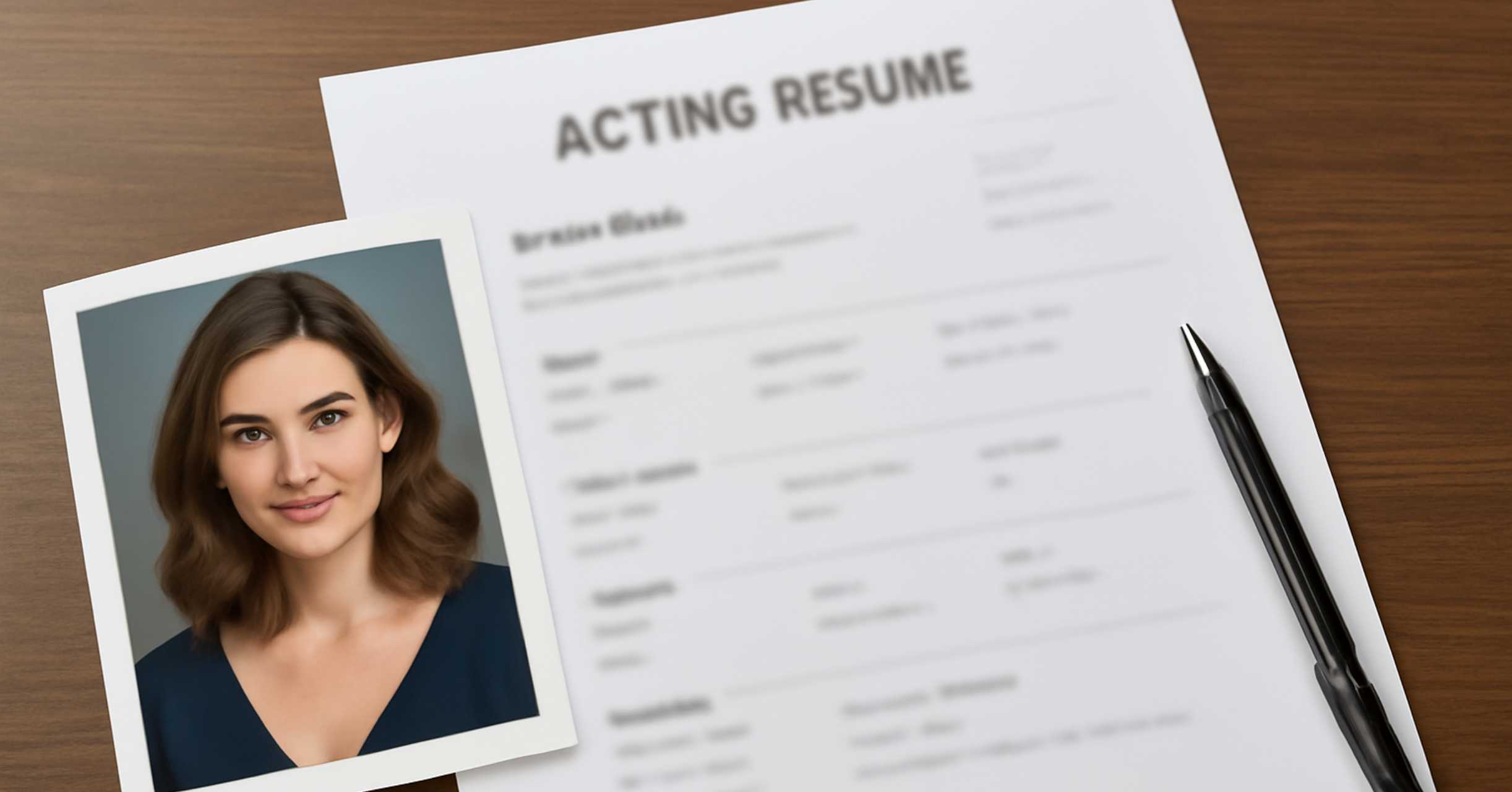Acting Resume 101: Create One That Stands Out
Format, templates, and tips for beginners and pros looking to book more roles in 2025.

Whether you're just starting out or you’ve been on stage or screen for years, your acting resume is one of the most powerful tools you have to land the next gig. Unlike traditional resumes, an acting resume is a carefully structured one-page snapshot of your performance history, training, and skills—custom-built to showcase you as a working (or aspiring) actor.
This guide will walk you through how to create an acting resume that stands out, including formatting tips, what to include (and what to leave out), and how to tailor your resume to different roles.
What Is an Acting Resume?
An acting resume is a professional document that lists your experience, training, and special skills relevant to acting. It’s attached to the back of your headshot and submitted to casting directors, agents, and producers as part of your audition package.
While your photo gets their attention, your resume convinces them you’re worth auditioning.
How to Format Your Acting Resume
- Keep it to One Page
Always keep your resume to a single page—no exceptions. Casting directors sift through hundreds of resumes. Make it easy for them to spot your strengths fast. - Use Standard Sections (In This Order):
- Contact Info
- Physical Stats
- Union Affiliation (if applicable)
- Credits (TV, Film, Theatre, Commercial)
- Training
- Special Skills
- Use Clean, Legible Fonts
Stick to Helvetica, Arial, or Times New Roman in 10–12 pt size. Use bold or ALL CAPS to differentiate section titles. Avoid color or graphic design elements.
What to Include in Each Section
Contact Info
Include:
- Your full name (top center or left-aligned)
- Professional email address
- Phone number
- Personal website (if you have one)
- Agent or manager’s contact info (if applicable)
Do NOT include your home address.
Physical Stats
These help casting directors match you visually to a role. Include:
- Height
- Weight (optional)
- Hair color
- Eye color
- Vocal type (for musical theater)
Union Status
Mention if you are a member of:
- SAG-AFTRA
- Equity (AEA)
- ACTRA (for Canadian actors)
If you’re not a member, write “Non-Union.”
Credits
Divide this section by category: Film, Television, Theater, and Commercial (optional). For each credit, list:
- Role
- Production Title
- Production Company or Venue
- Director (optional)
Example – Film:
- Lead | City Lights | XYZ Films | Dir. John Doe
Example – Theater:
- Juliet | Romeo & Juliet | NY Fringe Festival | Dir. Sarah Moore
List only the most relevant and impressive credits for the role you’re submitting for.
Training
List acting classes, conservatories, degrees, and private coaching.
Examples:
- BFA in Acting – NYU Tisch School of the Arts
- Scene Study – Howard Fine
- Voice & Speech – Kristen Linklater Technique
Be specific with names and styles—it shows professionalism and commitment.
Special Skills
This section is where you can stand out with unique, useful, and believable skills:
- Dialects (e.g., British RP, Southern US, Australian)
- Sports (e.g., fencing, gymnastics, horseback riding)
- Musical instruments (e.g., piano, guitar, violin)
- Languages (fluent or conversational)
- Stage combat / stunt training
- Improv or comedy training
- Accents and impressions
Pro Tip: Only list skills you're actually proficient in—casting directors might ask you to demonstrate them.
Tailor Your Resume to the Role
Just like tailoring a cover letter, you should adjust your resume based on the role or type of project:
- For theater auditions, highlight your stage credits and classical training.
- For film and TV, list screen credits first and prioritize on-camera training.
- For voice acting, include demo reel links, vocal range, home studio gear, and relevant experience.
How to Attach Your Resume to Your Headshot
- Print your resume on 8x10-inch paper (same size as your headshot).
- Trim it to size if needed.
- Staple it at all four corners to the back of your headshot, with the photo facing out.
- For digital submissions, save your resume as a PDF using the filename format:
Firstname_Lastname_Acting_Resume.pdf
Bonus Tips to Make Your Acting Resume Stand Out
- Start Strong as a Beginner
If you're just starting out, include student films, community theater, or indie projects. Use your training section to show your dedication. Never lie—casting directors can spot padded resumes quickly. - Keep It Updated
Revisit and revise your resume every 1–3 months to reflect new training or credits. - Proofread Everything
Typos are red flags. Use Grammarly or have a friend proofread it.
Special Skills
This section is your opportunity to stand out with skills that could make you a perfect fit for a role. While an acting resume should focus on your ability to act, casting directors also want to know what else you bring to the table.
For example:
- Physical Skills: Stage combat, dance, acrobatics, horseback riding.
- Musical Talent: Piano, guitar, singing (if applicable to the role).
- Languages and Accents: Fluent in French, Spanish, or any regional accents you’re comfortable performing.
- Other Skills: Impressions, special effects makeup, voiceover work.
The key here is to only include skills you can realistically demonstrate. For example, don’t list a dialect if you're not confident performing it in a scene.
Frequently Asked Questions
Should I Include Background Work?
Casting directors often prefer professional roles over background or extra work. However, if your background work has been on a major production, you might consider listing it under your credits. Just be honest about your involvement. Label it as “Extra” or “Background” if necessary. For example:
- Background | The Great Escape | Universal Studios | Dir. Chris Nolan
But in general, extra work should be omitted unless it's your only experience or it's for a well-known production.
What If I Have No Credits?
If you're a beginner, it’s important to be transparent about where you are in your career. Don’t panic if you don’t have a long list of credits. Use the Training section to showcase any acting classes, workshops, and coaching you’ve received. Also, mention any performances you’ve done in community theater, student films, or web series.
If you’re just starting out, remember that everyone begins somewhere. Getting experience in smaller productions and gaining exposure will help you build your resume.
Do I Need a Demo Reel?
Yes, eventually. A demo reel showcases your talent and performance in a way that words alone cannot. Reels should be concise (1–2 minutes), showcasing your best work across different roles. You don’t need a full-length film; a few high-quality clips from different performances will suffice.
Should I Include Dates?
Typically, acting resumes do not include dates of performances. The reason is simple: dates can distract from your abilities and make you appear outdated. Casting directors are more focused on your current look and skillset than when you worked on a particular show or film. However, if a role or project is particularly relevant and you need to include dates, be sure to format them clearly so they don’t overwhelm the resume.
Common Mistakes That Get You Skipped Over
Padding the Resume
One of the biggest mistakes you can make is inflating your experience. Casting directors have likely worked with hundreds, if not thousands, of actors. They can tell when a resume is padded with fake credits or roles you didn’t truly perform. It’s always better to be honest and list what you’ve actually done.
Bad Formatting
Poor formatting is a deal-breaker. Make sure your resume is well-aligned, properly spaced, and easy to read. Avoid using too many different fonts, and keep text sizes consistent. If you’re unsure, look for examples of professional actor resumes to use as a guide.
Unprofessional Email Addresses
Casting directors take you seriously based on the way you present yourself. Using an unprofessional email (like “partyboy92@hotmail.com”) is an instant turn-off. Make sure your email is simple and professional, ideally containing your name (e.g., john.doe@email.com).
Listing Irrelevant Work
Including unrelated job experience—such as your role as a barista or intern at a marketing firm—is not necessary. Your resume should reflect your acting journey. If you’re just starting out, list relevant student films, theater productions, or workshops, but avoid non-acting work unless absolutely necessary.
Overcrowding the Page
Your resume should be easy to read and well-organized. If you crowd the page with too much text or small font, casting directors might struggle to read it. A cluttered resume feels overwhelming, so leave some white space and keep everything concise.
Submitting in the Wrong Format
Always submit your resume as a PDF. This ensures it retains its formatting across devices. Avoid sending it as a Word document or image file, as this can distort the layout.
Pro Tips from Working Actors and Casting Directors
“Focus on What You’ve Done, Not Just What You Want to Do” – Casting Director
"A casting director is hiring you for your talent and your ability to perform in the role. So, focus on showcasing your most relevant experience. Highlight the roles you've performed, not just the roles you're aspiring to play."
“Keep Your Resume Simple” – Actor with 20+ Years of Experience
"A resume shouldn’t be an essay. Focus on the essentials and make it as readable as possible. We don't need your whole life story. Keep it to the highlights that showcase you in your best light."
“Always Include Your Union Status” – Talent Manager
"Make sure you include your union status. Casting directors are always looking for union actors first, and if you’re eligible, you want to show that you're serious about your career."
Tools and Resources
If you’re looking for tools to help with formatting or building your resume, here are some great resources:
- Canva: Offers free templates and customization options for actors looking to create professional resumes.
- StageMilk Resume Builder: Offers guidance for beginners building a resume from scratch.
- Actor's Access: A professional platform where you can build, save, and upload your acting resume directly for casting submissions.
- Backstage: Offers an easy-to-use resume template along with casting calls.
There are also online communities for actors, such as Reddit’s Acting Subreddit, where you can get feedback on your resume from peers.
Final Checklist Before Submitting Your Resume
Before submitting your resume for that big audition or casting call, ensure you’ve checked everything:
- [ ] Is your name and contact info clear and accurate?
- [ ] Does your resume highlight relevant credits and training?
- [ ] Is your resume formatted cleanly with professional fonts?
- [ ] Have you double-checked for any spelling or grammatical errors?
- [ ] Is your resume saved as a PDF, and is the file name correct?
- [ ] Does your resume clearly reflect your union status, if applicable?
Conclusion
An acting resume is your first opportunity to make a great impression. It's your calling card, your introduction to casting directors, and a reflection of your commitment to your craft. By following these tips, avoiding common mistakes, and keeping your resume professional and concise, you’ll be on your way to securing auditions and landing roles.
Want help building or reviewing your acting resume? Join Actor Supply today for resume templates, casting alerts, professional advice, and tools to help you get cast in 2025.




.jpg)